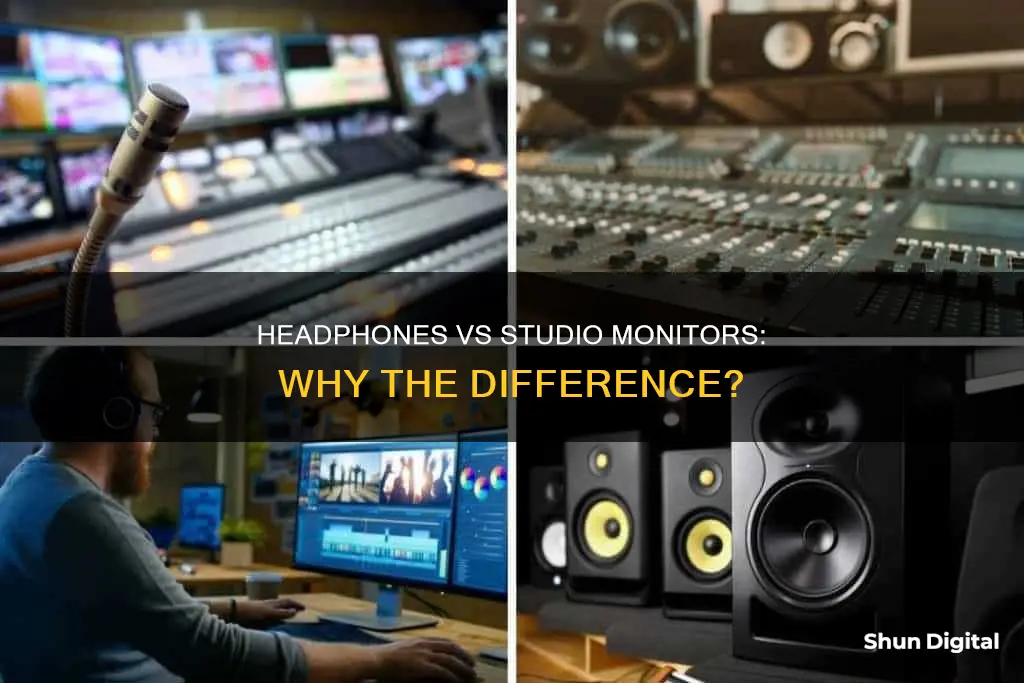
Mixing music on headphones or studio monitors can yield different results, and it's important to understand the advantages and disadvantages of both. Studio monitors offer a more authentic and natural representation of tracks, while headphones can provide a more detailed and intimate listening experience. The choice between the two depends on factors such as budget, space, and personal preference.
| Characteristics | Values |
|---|---|
| Sound quality | Studio headphones can provide a more "intimate" listening experience with increased bass perception and no distraction from outside noise. |
| Portability | Studio headphones are portable and can be used anywhere, anytime without bothering others. |
| Detail | Studio headphones are excellent for spotting tiny details, such as unwanted distortion, clipping, and clicks, allowing for critical listening during the mixing stage. |
| Comfort | Studio headphones can cause ear fatigue due to constant pressure on the ears, requiring frequent breaks. |
| Exciting experience | Studio monitors provide a more exciting and immersive experience as the listener is surrounded by sound and can feel the low-frequency sound waves. |
| Natural sound | Studio monitors offer a more natural and authentic representation of tracks as the sound waves are physically pushed around the room and affected by the environment. |
| Separation | Studio monitors provide better separation and clarity, allowing for a more accurate representation of the audio. |
| Flat frequency response | Studio monitors have a flatter frequency response, providing a neutral sound for mixing and mastering. |
| Sharing | Studio monitors are more suitable for sharing music with others in the studio. |
What You'll Learn

Studio monitors are more authentic and natural-sounding
Studio monitors are widely regarded as the most authentic and natural-sounding option for mixing music. This is because they are designed to provide an accurate representation of the audio by physically pushing sound waves around the room, which then reflect off and are absorbed by objects in the space. This creates a soundscape that feels natural and organic to the human ear.
Monitor speakers are also the most natural choice for the majority of people because they are the way we are most used to hearing music. The human auditory system is accustomed to processing two audio streams from the left and right ears, which is the experience provided by speakers. This is in contrast to headphones, where both ears receive their own channels at the same time, resulting in a perception of sound coming from inside the head, rather than externally.
Studio monitors also offer a more exciting listening experience. As you move your head and body around the room, you will hear different frequencies, allowing you to instinctively pick up on various details. This is a more dynamic and immersive experience compared to the static nature of headphone listening.
Additionally, studio monitors eliminate "ear fatigue" or "ear blindness", as the source of the audio is further from your ears, reducing the constant pressure on or around them. This allows for longer mixing sessions without discomfort and enables you to make intelligent decisions during the mixing and mastering process.
Finally, studio monitors are ideal for sharing your music with others. While headphones are great for individual listening, monitors facilitate a more social and fun experience, allowing you and your collaborators to enjoy the music together and providing a sense of communal excitement.
Monitoring Internet Usage: BigPond's Guide to Online Activity
You may want to see also

Headphones are more practical for shared spaces
Headphones, on the other hand, allow you to listen at a reasonable volume without bothering those around you. They are also great for spotting and homing in on details such as unwanted distortion, clipping, and clicks. You'll often hear details in tracks with headphones that you may have missed with studio monitors.
Additionally, studio headphones are generally cheaper to start out with and don't make noise that bothers other people. If you're in a shared space, you may not have the budget or the ability to use monitors without disrupting others. Headphones are a more practical option in this case.
Another benefit of headphones is that they cut out distracting room reflections and ambient noise. This is especially useful if you're in a space that isn't designed for mixing, such as a bedroom or apartment with thin walls. You can also use headphones at any time of day without worrying about the noise level, which gives you more flexibility in your work schedule.
While studio monitors may be the preferred choice for the most authentic and natural-sounding representation of your tracks, headphones are a more practical option for shared spaces due to their noise levels, affordability, and ability to cut out ambient noise.
Opening a ViewSonic LCD Monitor: Step-by-Step Guide
You may want to see also

Headphones can be more comfortable
Headphones are also a more practical option if you have thin walls and sensitive neighbours. Studio monitors are loudspeakers, and you need to drive them somewhere around 80dB SPL for the most balanced representation of all frequencies. This means that if your walls are thin and your neighbours are unsympathetic, you may have issues with running a set of monitor speakers for extended sessions. Headphones are a reliable alternative solution in this case, cutting out distracting room reflections and ambient noise.
Headphones are also great for spotting and homing in on details such as unwanted distortion, clipping, and clicks. With headphones, you'll often hear detail in tracks that you may have missed with normal monitors, which is especially useful when resolving things like tonal clashes between instruments in the same frequency range, wayward vocal timings, or pitching issues.
Additionally, an important advantage of headphones is that you can listen to them day or night, at a reasonable volume, without bothering the neighbours – something that can't be said for studio monitors.
Resizing Your Display: A Guide to Monitor Size Adjustment
You may want to see also

Studio monitors require a dedicated space
The ideal space for studio monitors is an acoustically treated room with a flat frequency response. This helps to produce a mix that sounds consistent across different playback scenarios, such as in a car or on a smartphone. However, not everyone has access to a dedicated mix room, and bedrooms or apartments often have thin walls, sensitive neighbours, or less-than-ideal acoustics.
In addition to the room itself, the placement of the monitors within the space is also important. Monitor speakers have cones that physically push sound waves around the room, so the layout of the room and the positioning of the speakers can impact the overall sound.
Another consideration when using studio monitors is the volume. Monitors need to be driven at around 80dB SPL for the most balanced representation of all frequencies. This can be a problem if you have thin walls or close neighbours, as it may disturb others or cause issues with extended mixing sessions.
Overall, while studio monitors provide a more authentic and natural-sounding representation of your tracks, they require a dedicated space with suitable acoustics, placement, and volume considerations.
Blind Spot Monitor: Standard on Rav4 XL?
You may want to see also

Studio monitors are better for sharing music
Studio monitors also eliminate "ear fatigue" as the source of the audio is further from you. You can also hear the sound in a more "natural" way that a listener would without headphones. Studio monitors allow you to better understand how your track will play back in a room. They offer better separation and clarity than most headphones.
Studio monitors are also better for sharing music as they allow for a more collaborative experience. Multiple people can listen to the music at the same time, which facilitates discussion and feedback. With headphones, only one person can listen at a time, which can be more isolating and less conducive to collaboration.
Additionally, studio monitors can provide a more consistent listening experience for everyone in the room. With headphones, each person may have a slightly different listening experience depending on the quality and characteristics of their headphones. Studio monitors ensure that everyone is hearing the music in the same way, which can lead to more effective communication and collaboration.
While headphones can be useful for certain aspects of music production and mixing, studio monitors ultimately provide a more authentic, natural, and collaborative experience for sharing music.
A Guide to Removing Ring of Elysium's Monitoring Completely
You may want to see also
Frequently asked questions
Studio monitors are built to provide an accurate representation of audio, so musicians can hear their work as it truly sounds. Headphones, on the other hand, can offer a more intimate and exciting listening experience, with increased bass and no outside noise distractions.
Studio monitors provide a more authentic and natural-sounding representation of your tracks. They are the most natural choice for mixing as they push sound waves around the room, which are then reflected and absorbed by objects, providing our brains with directional information that feels natural and organic.
Headphones are great for spotting small details in your music, such as unwanted distortion or clipping. They can also be used at any time of day without disturbing others and are often a more practical option due to their lower volume and portability.
It is recommended to use both studio monitors and headphones when mixing to get the best results. Studio monitors will give you a more accurate representation of your music, while headphones can help you hear the small details. Using a variety of different monitors and headphones to reference your work will also help you understand how your audio behaves in different environments.







